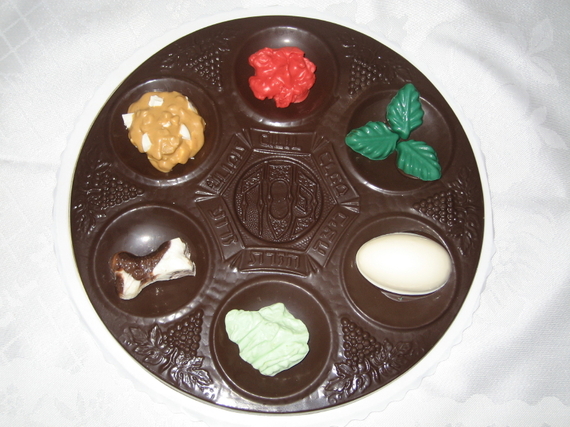Passover's chocolate layers new causes onto age-old themes of freedom, peoplehood and monotheism. Recent campaigns have responded to the need for chocolate that is both kosher for the festival and also fair trade certified. Until 2012 it was not possible to find both. Fair trade certification monitors economic justice for farmers and seeks the elimination of child slavery in cocoa farms, all extremely vital to the concerns celebrated at Passover.
Fair Trade Judaica's Founding Director, Ilana Schatz explains in an email to me her passion regarding fair traded chocolate.
In 2010 ... I was stunned to learn that this most delicious and heavenly food was being produced by slave labor! Two things were immediately obvious: the connection to a contemporary Pesach story and the fact that there was no chocolate we could eat on Passover that wasn't probably tainted by child labor.
As a result of her efforts over these past five years, we are finally able to find chocolate fashioned without child slavery. This chocolate deserves a place at our Seder table from both a Jewish and labor justice perspective. Massachusetts-based Equal Exchange Chocolate now serves up tasty kosher-for-Passover chocolate bars that are also certified fair trade. (These Equal Exchange bars need to be bought prior to Passover according to the Rabbinical Assembly's approved list for Passover foods.)
A recent collaboration among Fair Trade Judaica, T'ruah: The Rabbinic Call for Human Rights and Equal Exchange has created a fundraising program partnership for synagogues and organizations to widen distribution of the bars that were first certified by Rabbi Aaron Alexander, Associate Dean of the Ziegler School of Rabbinic Studies at American Jewish University in Los Angeles.
To further awareness of slavery in our chocolate, Schatz also developed a "Virtual Fair Trade Chocolate at Seder" campaign. This decorates the Seder plate with cocoa beans. The beans or photos of cocoa beans, cocoa pods and/or cocoa trees help participants keep in mind the importance of kosher-for-Passover chocolate companies seeking fair trade certification. Any or all of these prompt awareness of child slavery in the chocolate industry. When explaining the cocoa on the Seder plate, Rabbi Menachem Creditor's prayer could be cited: "This is a symbol of potential freedom, a realization that foods that give me delight can be made without child labor." (The fuller text may be found at the Fair Trade Judaica website.)
In a different type of campaign, the popular mid-century Bartons Candy bundled educational materials about Jewish life and religion kosher-for-Passover treats such as Chocolate Matzah, Matzah Balls, and Almond Kisses. In the Bartons Haggadah issued in 1944, the Orthodox company founder and president, Stephen Klein, explained: "This haggadah is part of Bartons' program of presenting useful and informative literature for each Jewish holiday placed in every box of Bartons confections." Bartons Chocolate furthered the cause of Judaism and the teachings of Passover.
The texts accompanying the chocolate ritual foods in "A Haggadah for a Chocolate Seder" (free download) unwrap themes of ethical kashrut, worker equity and food justice. This spotlights Passover's underlying messages of freedom, dignity and fairness. The haggadah recognizes those who labor, often in great poverty, to grow and harvest cacao, including thousands of children and adolescents who work in bondage on the cocoa farms of Ivory Coast and Ghana. Select passages from the Chocolate Haggadah to add to your seder celebration or run a full chocolate seder.
Each of these chocolate causes builds on a long tradition of Passover values and Jewish ideals. Slather chocolate onto matzah this Passover while honoring choices that advance freedom.
Chocolate Matzah Brickle
This easy-to-prepare concoction is an ideal dessert or snack. We enjoy combining roasted almonds, candied orange peel, cocoa nibs and candied ginger for added zest.
•2 pounds dark Fair Trade and Kosher for Passover chocolate, chips or broken into pieces
•1/4 cup vegetable oil
•1/2 to 1 teaspoon vanilla or almond extract
•1 box matzah sheets, broken into quarters
•1 cup chopped nuts
•1 cup chopped dried fruits
1. Line a large baking sheet with parchment paper or waxed paper.
2. Melt the chocolate in a large heatproof bowl set over a pan of simmering water.
3. Once melted, thin the chocolate with the vegetable oil; stir in the vanilla or almond extract.
4. Coat the matzah, nuts and dried fruits with the chocolate and spread onto the prepared baking sheet.
5. Place the sheet in the refrigerator for at least 1â „2 hour to cool.
6. Once cool and hardened, remove from the pan and break into bite-size bits. Store in a closed container.
Deborah R. Prinz lectures about chocolate and religion around the world. Her book, "On the Chocolate Trail: A Delicious Adventure Connecting Jews, Religions, History, Travel, Rituals and Recipes to the Magic of Cacao," was published in 2013 by Jewish Lights and is in its third printing. The book is used in adult study, classroom settings, book clubs and chocolate tastings.
An earlier version of this article was published at the Jewish Journal.

